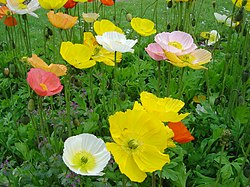Papaver: Difference between revisions
m Removed taxobox colour. See User:Eubot/Removing colours from taxoboxen. |
m Added 1 species name to list. |
||
| Line 41: | Line 41: | ||
*''[[Papaver acrochaetum]]'' |
*''[[Papaver acrochaetum]]'' |
||
*''[[Papaver aculeatum]]'' : South African Poppy |
|||
*''[[Papaver alboroseum]]'' : Pale Poppy |
*''[[Papaver alboroseum]]'' : Pale Poppy |
||
*''[[Papaver alpinum]]'' : Dwarf Poppy |
*''[[Papaver alpinum]]'' : Dwarf Poppy |
||
Revision as of 13:47, 7 April 2008
| Papaver | |
|---|---|

| |
| Iceland Poppy (Papaver nudicaule) | |
| Scientific classification | |
| Kingdom: | |
| Division: | |
| Class: | |
| Order: | |
| Family: | |
| Genus: | Papaver |
| Species | |
|
See text. | |
Papaver is a genus of poppies, belonging to the Poppy family (Papaveraceae).
Its 120-odd species include the opium poppy and corn poppy. These are annual, biennial and perennial hardy, frost-tolerant plants growing natively in the temperate climates of Eurasia, Africa and North America (Canada, Alaska, Rocky Mountains). One section of the genus (Section Meconella) has an alpine and circumpolar arctic distribution and includes some of the most northerly-growing vascular land plants.
Papaver grows in disturbed soil. Its seeds may lay dormant for years until the soil is disturbed. Then they bloom in great numbers under cool growing conditions.
The large, showy terminal flowers grow on long, hairy stalks, to a height of even 1m or more as in the Oriental Poppy (Papaver orientale). Their color vary from the deepest crimson, lilac, or white, or violet, to bright yellow or soft pink. The tissue-paper-like flowers may be single, double or semi-double. The size of these flowers can be amazing, as the Iceland Poppy (Papaver nudicaule) grows to 15-20 cm across.
The flower buds are nodding or bent downwards, turning upwards as they are opening. There are two layers. The outer layer of two sepals drops off as the bud opens. The inner layer consists of 4 (but sometimes 5 or 6) petals. There are many stamens in several whorls around a single pistil.
The ovary later develops in a poricidal capsular fruit, capped by the dried stigma. The numerous, tiny seeds escape with the slightest breeze through the pores of the capsule.
Poppies have a long history. They were already grown as ornamental plants since 5,000 BC in Mesopotamia. They were found in Egyptian tombs. In Greek mythology, the poppy was associated with Demeter, goddess of fertility and agriculture. People believed they would get a bountiful crop if poppies grew in their field, hence the name 'corn poppy'. In this case, the name 'corn' was derived from 'korn', the Greek word for 'grain'.
They are also sold as cut flowers in flower arrangements, especially the Iceland Poppy. They deserve a prominent place in any garden, border, or in meadow plantings. They are probably one of the most popular wildflowers.
In the course of history, poppies have always been attributed important medicinal properties. The alkaloid rhoeadine is derived from the flowers of the Corn Poppy (Papaver rhoeas). This is used as mild sedative. The stems contain a latex or milky sap. This may cause skin irritation, and the milky sap present in the Opium Poppy (Papaver somniferum) contains several narcotic alkaloids including morphine and codeine.
Species




- Papaver acrochaetum
- Papaver aculeatum : South African Poppy
- Papaver alboroseum : Pale Poppy
- Papaver alpinum : Dwarf Poppy
- Papaver apokrinomenon
- Papaver apulum
- Papaver arachnoideum
- Papaver arenarium
- Papaver argemone : Long Pricklyhead Poppy
- Papaver armeniacum
- Papaver atlanticum : Atlas Poppy, Moroccan Poppy
- Papaver aurantiacum
- Papaver belangeri
- Papaver berberica
- Papaver bipinnatum
- Papaver bracteatum
- Papaver californicum : Fire Poppy, Western Poppy
- Papaver clavatum
- Papaver commutatum
- Papaver croceum : Ice Poppy
- Papaver curviscapum
- Papaver cylindricum
- Papaver dahlianum : Svalbard Poppy
- Papaver decaisnei :
- Papaver dubium : Long-headed Poppy, Blindeyes
- Papaver fugax
- Papaver glaucum : Tulip Poppy
- Papaver gorgoneum :
- Papaver gorodkovii : Arctic Poppy
- Papaver gracile :
- Papaver guerlekense
- Papaver hybridum : Round Pricklyhead Poppy
- Papaver kluanense : Alpine Poppy
- Papaver lacerum
- Papaver lapponicum : Lapland Poppy
- Papaver lasiothrix
- Papaver lateritium
- Papaver macounii : Macoun's Poppy
- Papaver mcconnellii : McConnell's Poppy
- Papaver nudicaule : Iceland Poppy, Icelandic Poppy
- Papaver orientale : Oriental Poppy
- Papaver paucifoliatum
- Papaver persicum
- Papaver pilosum :
- Papaver polychaetum
- Papaver postii
- Papaver pseudo-orientale : Oriental Poppy
- Papaver purpureamarginatum
- Papaver pygmaeum : Pigmy Poppy
- Papaver radicatum : Rooted Poppy
- Papaver rhoeas : Common Poppy, Corn Poppy, Annual Poppy, Flanders Poppy, Shirley Poppy.
- Papaver rhopalothece
- Papaver rupifragum : Spanish Poppy
- Papaver sendtneri : White Alpine Poppy
- Papaver somniferum : Opium Poppy
- Papaver spicatum
- Papaver strictum
- Papaver stylatum
- Papaver syriacum
- Papaver triniifolium
- Papaver umbonatum :
- Papaver walpolei : Walpole's Poppy
External links

